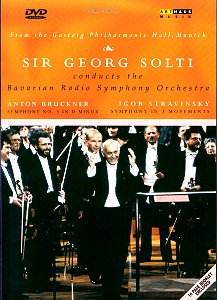DVD booklets generally seem to supply duff information or not enough
and be generally thoughtless. Bruckner 3 is an edition-minefield of
a symphony. Any self-respecting Brucknerian needs to know the version
being played. The only help the booklet (not the outside cover) gives
is to say 1877. That’s something – but whose edition? OK, Solti recorded
Bruckner symphonies for Decca in Chicago – a mixed bag – and he used
1877/Nowak for No.3. As he does here – Nowak (unlike Oeser) ignored
Bruckner’s request that the coda to the ‘Scherzo’ be suppressed. You
won’t find this information in the booklet, although the notes do refer
to the 1873 original and the second revision of 1889.
Only the year of 1993 is documented for these filmed
performances. "Two live concerts" reports the English note;
I think it’s one concert – there’s no reason why these very different
symphonies can’t go together (Solti played the Stravinsky with Bruckner
4 at a LSO concert).
So, two symphonies requiring listening to … what use
the film? Well, there are examples of images dissolving one to the other,
which I find irritating. Otherwise, there’s a lot of focus on Solti
– rightly so, love or hate him he was a presence and an individual –
and close-ups of solo players and broader shots of the whole orchestra.
Both performances are impressive, if somewhat compromised
by rather uningratiating sound (the Bruckner more so), which is partly
Solti himself in loud passages – brass sometimes too dominant and suggesting
a capacity for laceration. Bruckner 3 is at its best earlier on. Solti’s
majestic account of the first movement has much lyrical import and sensitive
playing and his patience with the music is admirable. The opening of
the slow movement is lovingly shaped … yet the remaining movements can
be over-emphatic; a shame, for the ‘Scherzo’ is also excitingly punchy.
The dance elements (‘Trio’, and the second-subject jig of the ‘Finale’)
are well paced but lack natural buoyancy. The symphony’s ultimate peroration
is rather grandiose if well received. This is the same hall where Celibidache
gave so many wonderful Munich Philharmonic concerts; his Bruckner (EMI)
a (sound)world apart from Solti’s.
When I first heard Solti conduct Stravinsky’s masterly
symphony (the LSO concert previously mentioned), I was surprised as
to how deliberate he was with it – more to Klemperer than to Colin Davis
(I’m thinking of the latter’s first, LSO, recording). Having been disappointed
with Solti’s Chicago/Decca recording of it, it’s gratifying that this
Bavarian Radio one is so good. Just occasionally Solti forces details,
but his rhythmic alacrity and emotional response make a charismatic
combination. The concertante piano and harp are always audible and,
visually, well in shot. Solti’s incisive account allows no sagging,
his moderate tempos bringing clarity but no lack of heft – this is a
gritty and determined account that ranks with the best available. Its
precision and pungency might surprise Solti’s detractors.
If my response has been primarily that of a listener,
I must also mention that the pictures do give welcome insights – not
least Solti smiling at players when things go well and the orchestra-view
of his mix of control and involvement … and those eyes, the eyes of
someone who knew what he wanted and was determined to get it.
Colin Anderson


